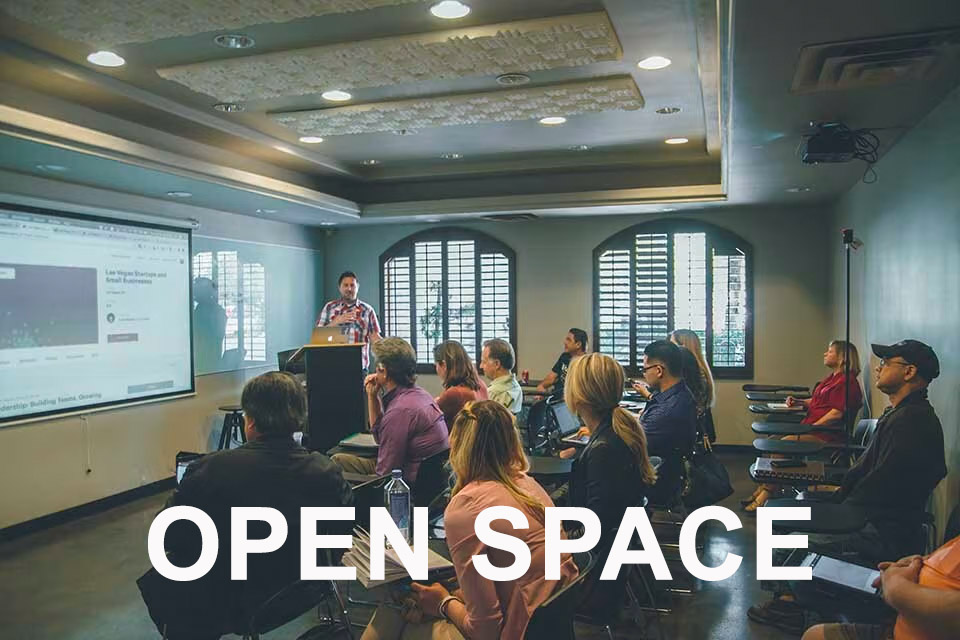What is Open Space?
Table of Contents: Definition – Proceeding – Principles – Advantages – Disadvantages – Tips – In-house Open Spaces – Download – Notes
Smartpedia: Open Space is a participative conference format in which participants plan topics to be discussed in a self-organised way and then discuss them in individual groups.
Open Space Definition
Open Space is a method for structuring and conducting a conference or convention. In contrast to “classical” conferences, in which several lecturers usually present topics and contents frontally and monologically to the participants in a sequence, the participants themselves become lecturers in an Open Space. Participants will become active contributors, sharing experiences, discussing questions, posing challenges or asking for support in conflicts.
In addition, the participants/contributers plan the topics to be discussed in a self-organised way, each participant decides freely which topic or topic session he would like to participate in and where he would like to participate actively in a discussion. Open Space is thus a participative conference format.
The idea of the Open Space Method – sometimes also called Open Space Technology (OST) – is attributed to the US-American Harrison Owen, a priest and civil rights activist. It is supposed to be based on his observations that the most productive parts of meetings have always been coffee breaks and other unorganised get-togethers. In the mid-1980s, companies saw it as an opportunity to promote employee participation and interest in corporate affairs. The idea that many valuable discussions take place during coffee breaks can also be observed today at many classic conferences: at the latest every second lecture is followed by a break that is long enough not only to get a drink but also to exchange ideas.
The Proceeding of an Open Space
How an Open Space runs can be very different. Basically, the following aspects should be included in the process:
- Welcome of the participants by the organisers.
- Description of the process (when, who, where, what, how long etc.).
- Introduction to the topic (if there is a pre-defined topic that sets a certain framework for the event).
- Possibly short introduction round (if the Open Space takes place within the company, this is usually more sensible than at a public event with hundreds of participants).
- Collection of topics – either in a sequence, so that participants present their topic immediately by an elevator pitch, or in parallel on a large wall, on which possible (partial) topics are noted down on notes (DIN A5 / A4 / A3) and then attached for everyone to see.
- Marketplace – the place where the organisation of the conference day takes place. Suggested topics are arranged, grouped or summarised if necessary, arranged in chronological order and assigned to individual rooms. Some guidebooks recommend the use of “registration lists”, especially for larger groups, but this contradicts an essential “law” at Open Space (see principles and a law). It is better to ask for an expression of interest by hand signal for competing topics and limited premises / times.
- Work in the topic groups, whereby the design of each individual group is the responsibility of the participants. For example, a question could be discussed, a procedure developed or an idea jointly developed.
- Collection of results – ideally contents, questions and findings are documented in the individual topic groups, which are compiled in the plenum at the end of the event and briefly summarised.
- Outlook – what will happen with the contents, questions and findings? Is there another Open Space, if so, when and where? How are insights spread within the organisation? Etc.
Principles and a Law of Open Spaces
There are four principles and one law to the Open Space format. Here are the principles:
- Those who are there are exactly the right ones. Since each participant attends a session voluntarily, it is important to use this interest and ideally also the energy and knowledge of the participant / contributor. On the other hand, it makes little sense to think of those who are not there.
- Whatever happens, it is the only thing that could have happened. The focus is on direct exchange, discussion or answering questions. Everything that could have been, but didn’t happen, is secondary.
- It begins when the time is right. Yes, there is a timetable, but there can always be delays. Punctuality is neither a goal nor an important aspect. What is important is when the energy in the group is so high that it is possible to work together. In practice, this can lead to a session ending earlier or lasting longer than planned. This leads to the fourth principle.
- It is over when it is over. It’s not over until it’s over.
And the law:
At Open Space, the “law of two feet” applies. It expresses an essential part of the self-responsibility of the participants. It is expressly desired that participants leave a group or session if they can’t take anything with them or don’t want to share anything. This consideration is expressed in the two terms “bumble bees” and “butterflies”:
- The “bumble bees” fly from session to session and “pollinate” individual groups with knowledge and insights that they have gained in discussion rounds in which they have participated before. Bumble bees thus contribute significantly to the networking of content and knowledge.
- The “butterflies” settle in quiet places (the coffee bar, the buffet etc.). These apparent places of inactivity unfold a life of their own, because there is a regular exchange of themes, insights or observations, which can later be communicated again in working groups.
Some Open Space descriptions also mention an “elephant”: he initiates or joins a working group and remains an active member of the group from start to finish.
Advantages of Open Spaces
The Open Space technology offers the following advantages:
- The exchange is promoted by the participation of the attendees from the beginning.
- Individual – even complex – questions can be answered by a kind of swarm intelligence or expert knowledge.A
- lthough the topic of the event is often an framework, there is still the opportunity to discuss topics that are somewhat “apart” from it in the sessions or outside the group work (as a “butterfly”).
- Because many people can have their say, the mood usually rises. Especially when it comes to unfolding “energy” for a “thing”, the Open Space method is very suitable. Thus the format is community-forming and promotes the motivation for co-operation.
- Through successful documentation, participants can also benefit from the findings, although they were not involved in the concrete development and acquisition of the findings.
Disadvantages of Open Spaces
Of course there are also some disadvantages:
- The Open Space format ideally takes place at eye level. It is about exchange, learning from each other and cooperation. Within companies, however, this is often difficult when employees from different hierarchical levels interact with each other. Here, the initiator of the topic or group work is required to act as a moderator. But is he technically and organisationally able to do this?
- There are introverted and extroverted people. Introverted people often have a hard time with Open Spaces.
- The participation in an Open Space should be voluntary, because this voluntariness is part of the self-determination of the participants. However, this is not always the case with internal Open Spaces. Without voluntary participation, the willingness to participate suffers. The same applies to the “overarching” topic; it only promotes participation if the attendees are interested.
- The success of internal Open Spaces stands and falls with the corporate culture: if the exchange within an organisation serves a common goal, then the findings should be implemented accordingly. However, if individual managers then decide completely differently, the Open Space format is useless through no fault of their own.
Tips for the execution of Open Spaces
There are also a number of tips for conducting open spaces:
- Ideally, the spaces are separated so that the work of one group does not affect another group. An open-plan office or a factory floor are also “open spaces”, but do not serve the purpose of a concentrated exchange of knowledge.
- In many parallel sessions, the overview of content and locations is quickly lost. It therefore makes sense to position the plan drawn up jointly in the marketplace centrally for viewing and, if necessary, to place further copies of it in central positions.
- It is advisable to provide sufficient presentation materials (laptop, projector, whiteboards, paper, pens, post-it, etc.) in each room.
- Often participants take part in an Open Space for the first time. For those who are interested in initiating their own session or working group, separate guides can be provided to answer questions in advance or to help with implementation and moderation.
- Open Space thrives on participation. A monologue or a frontal presentation as at a “classical conference” within a working group is therefore not effective.
- Even if punctuality is not a primary goal, it makes sense to inform the initiator 5 minutes before the end of a session that the planned time will soon end.
The journey from one session to the next – possibly even with a detour via the coffee bar – takes time. This time should be taken into account when scheduling. - The summary of individual sessions and the provision of corresponding information in the aftermath of the event is important for further work.
Sometimes we read that the initiator could also leave his own working group and change to another group like a ” bumble bee “. However, the initiator should refrain from this! - The context of the event can be very well defined with an impulse lecture, which is addressed to all participants at the beginning of the conference and addresses a specific topic.
Opinions differ, by the way, as to whether the organisers of Open Spaces should oblige the participants to use “first names” only. The situation is similar with nameplates: some organisers do without surnames, roles and/or company names. This should also promote the exchange at eye level, but sometimes this is at the expense of better orientation. Here it could make sense to install a “bulletin board” on which each participant asks his questions, for which he seeks answers, and each contributor propagates his expert knowledge so that it can be found by other participants.
In-house Open Spaces
Especially when Open Spaces are being held in-house for the first time, some questions arise: How can colleagues be won over as participants? How can management agree to the project even though neither the content nor the result can be determined in advance? Who invites to the Open Space? How can the participants be motivated? Etc.
It may be helpful to prepare the session planning for the first in-house Open Space with Liberating Structures – e.g. per Purpose to Practise or 25/10 – and to avoid ad hoc topic suggestions. In the run-up to the event, pioneers could also be acquired who have a good standing internally and are willing to offer a session. Some guidebooks also recommend collecting and evaluating topics on the intranet. Or to engage sparring partners for sponsors at an early stage. All these considerations focus on one aspect: security. The security that the Open Space will succeed. That there will be an exchange and that relevant topics will be discussed. If the participants experience that the sessions are expert lectures, discussions, presentations of methods, open questions, etc., and that there is an exchange at eye level, security quickly increases. And as a result, the desire for security decreases. Participants become contributors.
What are the advantages and disadvantages of doing it on-site or online?
Notes:
Here you can find a list of Bar Camps in Germany, Austria and Switzerland that use the Open Space method.
If you like the article or would like to discuss it, please feel free to share it in your network. And if you have any comments, please do not hesitate to send us a message.
Here you can find additional information from our t2informatik Blog:




